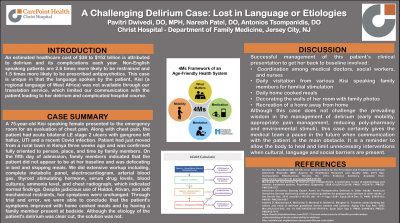Back

Medical Education
A Challenging Delirium Case: Lost in Language or Etiologies
Friday, March 31, 2023
12:00 PM East Coast USA Time

- PD
Pavitri Dwivedi, DO (she/her/hers)
Family Medicine Resident/Chief Resident
Christ hospital- Care Point Health
Jersey City, New Jersey, United States
Presenting Author(s)
Introduction: A 75 year old Kisii (regional language of West Africa) speaking female presented to the Emergency room for an evaluation of chest pain. Per initial presentation, the patient made no eye contact and appeared uncomfortable. Patient had just moved from a rural town in Kenya 3 weeks ago and was confirmed A&Ox3 by family members. Along with chest pain, the patient had acute bilateral LE stage 2 ulcers with gangrene left hallux, UTI and a recent Covid infection. On the 5th day of admission, patient started sundowning with increasing agitation and confusion. Despite PRN orders for Haldol, Ativan, and soft mechanical restraints, her symptoms were unchanged. This case is unique in that the Kisii language was not provided by any translation service and the lack of the ability to communicate with the patient contributed to her delirium leading to a complicated hospital course. An estimated healthcare cost of $38 billion to $152 billion is attributed to delirium and its complications each year. Non-English speaking patients are 2.6 times more likely to be restrained and 1.5 times more likely to be prescribed antipsychotics.
Case Study: Per family, the patient did not appear to be at her baseline and was defecating in bed and skipping meals. Due to the patient’s presenting symptoms, extensive work up was completed including, CBC, TSH, serum drug levels, CMP, ABG, ECG, blood cultures, ammonia, and chest radiograph, which did not indicate any acute findings. Nursing and case management team was involved for further interventions. Through trial and error, we were able to conclude that the patient's symptoms improved with home cooked meals and a family member present overnight. Although the etiology of the patient's delirium was clear cut, the solution to it was not as this involved coordination by the medical doctors, social workers, and most importantly the family members so that they could be present during the rest of the patient's hospitalization for communication and providing a "home away from home" for the patient that ultimately lead to her improvement.
Discussion: Although this case does not challenge prevailing wisdom in the management of delirium (early mobility, appropriate pain management, reducing polypharmacy and environmental stimuli), this case certainly gives the medical team pause in the future when communication with the patient is the main obstacle. It is a reminder to allow the body to heal and limiting unnecessary interventions when cultural, language and social barriers are present.
Case Study: Per family, the patient did not appear to be at her baseline and was defecating in bed and skipping meals. Due to the patient’s presenting symptoms, extensive work up was completed including, CBC, TSH, serum drug levels, CMP, ABG, ECG, blood cultures, ammonia, and chest radiograph, which did not indicate any acute findings. Nursing and case management team was involved for further interventions. Through trial and error, we were able to conclude that the patient's symptoms improved with home cooked meals and a family member present overnight. Although the etiology of the patient's delirium was clear cut, the solution to it was not as this involved coordination by the medical doctors, social workers, and most importantly the family members so that they could be present during the rest of the patient's hospitalization for communication and providing a "home away from home" for the patient that ultimately lead to her improvement.
Discussion: Although this case does not challenge prevailing wisdom in the management of delirium (early mobility, appropriate pain management, reducing polypharmacy and environmental stimuli), this case certainly gives the medical team pause in the future when communication with the patient is the main obstacle. It is a reminder to allow the body to heal and limiting unnecessary interventions when cultural, language and social barriers are present.
